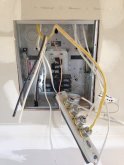So, tell me how you would do it.. I have some ideas but want some other perspectives.
We have a few acres of bare ground in the mountains where we have been managing well for years in a run down camp trailer with a single 12v deep cycle marine battery that I charge one or two times a year. It runs the lights, and an RV water pump, nothing more.
I am building an 8'x20' cabin (this size since its on a trailer frame that will, however, not be mobile). Its really more of a glorified tent as it is simply a bed, few chairs, a small stove and a small kitchenette. We will use it 3 seasons and little if any in the winter.
The desire is to have a few lights (4-5), a few 110 outlets for charging laptops, some USB outlets for phone charging, and an RV pump for kitchen sink.
Additional possibilities if we go crazy would be a small 12v fridge/cooler, and maybe the occasional random AC appliance. We don't have TVs or Internet here so an inverter would get used a bit but not on a regular basis.
Since I'm building this myself, should I just wire it up all AC and use an inverter off of solar charged batteries, or should I go with a mixed DC/AC system?
I thought about going with DC lighting, USB charging, and pump for the sink. Then have a run of regular romex and AC outlets on an inverter. It seems however with the limited lighting options for DC I might be able to just do it as a whole AC system and just run off of an inverter.
I currently have the following to start with:
* Crusty first gen Harbor Freight solar system
* 1 12v lead acid (Interstate srm-29) deep cycle marine battery
* Honda eu2000i generator
* Xantrex Xpower 1000 inverter (1000w)
I was thinking about purchasing:
* Renogy 100w 20A kit with bluetooth module OR maybe an MPP 1012LV-MS 1000w 12v MPPT 40A all in one.
* A couple 1'x1' 12v LED panels for the ceiling (35w each)
Aaand thats about as far as I got before I started overthinking it all......
So.. All AC via solar->batteries->inverter or do some mix of AC and DC wiring in the walls. Or other?
Thanks all!
We have a few acres of bare ground in the mountains where we have been managing well for years in a run down camp trailer with a single 12v deep cycle marine battery that I charge one or two times a year. It runs the lights, and an RV water pump, nothing more.
I am building an 8'x20' cabin (this size since its on a trailer frame that will, however, not be mobile). Its really more of a glorified tent as it is simply a bed, few chairs, a small stove and a small kitchenette. We will use it 3 seasons and little if any in the winter.
The desire is to have a few lights (4-5), a few 110 outlets for charging laptops, some USB outlets for phone charging, and an RV pump for kitchen sink.
Additional possibilities if we go crazy would be a small 12v fridge/cooler, and maybe the occasional random AC appliance. We don't have TVs or Internet here so an inverter would get used a bit but not on a regular basis.
Since I'm building this myself, should I just wire it up all AC and use an inverter off of solar charged batteries, or should I go with a mixed DC/AC system?
I thought about going with DC lighting, USB charging, and pump for the sink. Then have a run of regular romex and AC outlets on an inverter. It seems however with the limited lighting options for DC I might be able to just do it as a whole AC system and just run off of an inverter.
I currently have the following to start with:
* Crusty first gen Harbor Freight solar system
* 1 12v lead acid (Interstate srm-29) deep cycle marine battery
* Honda eu2000i generator
* Xantrex Xpower 1000 inverter (1000w)
I was thinking about purchasing:
* Renogy 100w 20A kit with bluetooth module OR maybe an MPP 1012LV-MS 1000w 12v MPPT 40A all in one.
* A couple 1'x1' 12v LED panels for the ceiling (35w each)
Aaand thats about as far as I got before I started overthinking it all......
So.. All AC via solar->batteries->inverter or do some mix of AC and DC wiring in the walls. Or other?
Thanks all!



